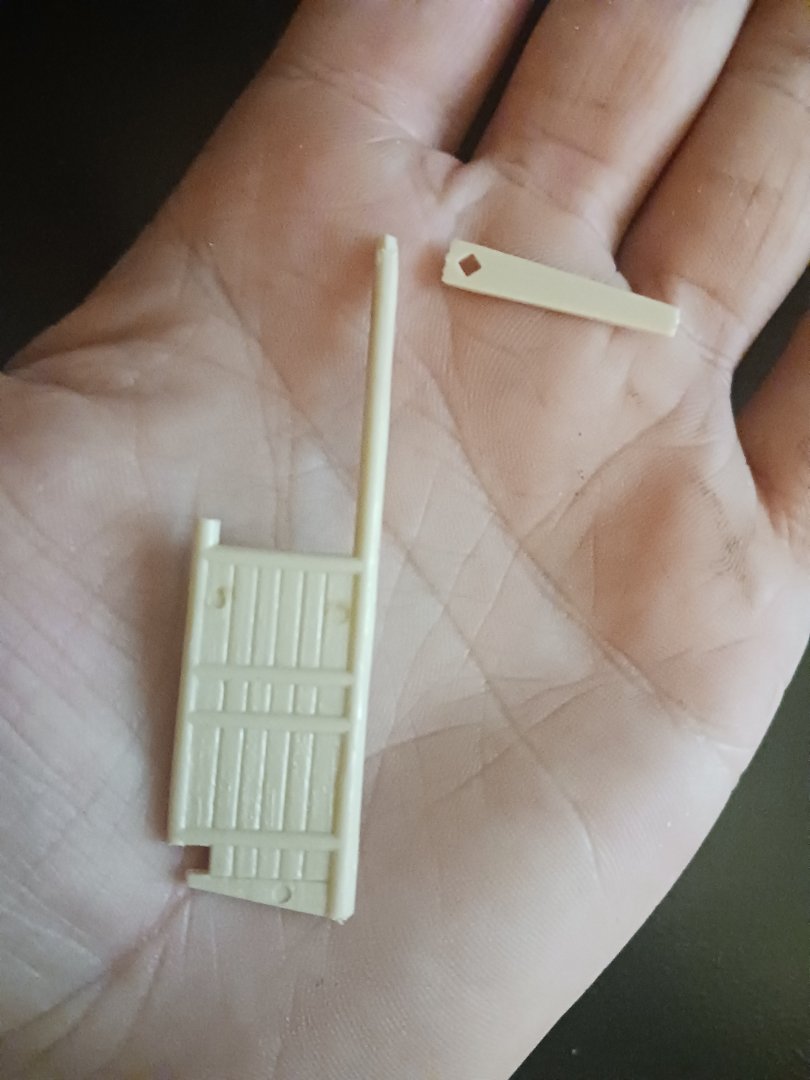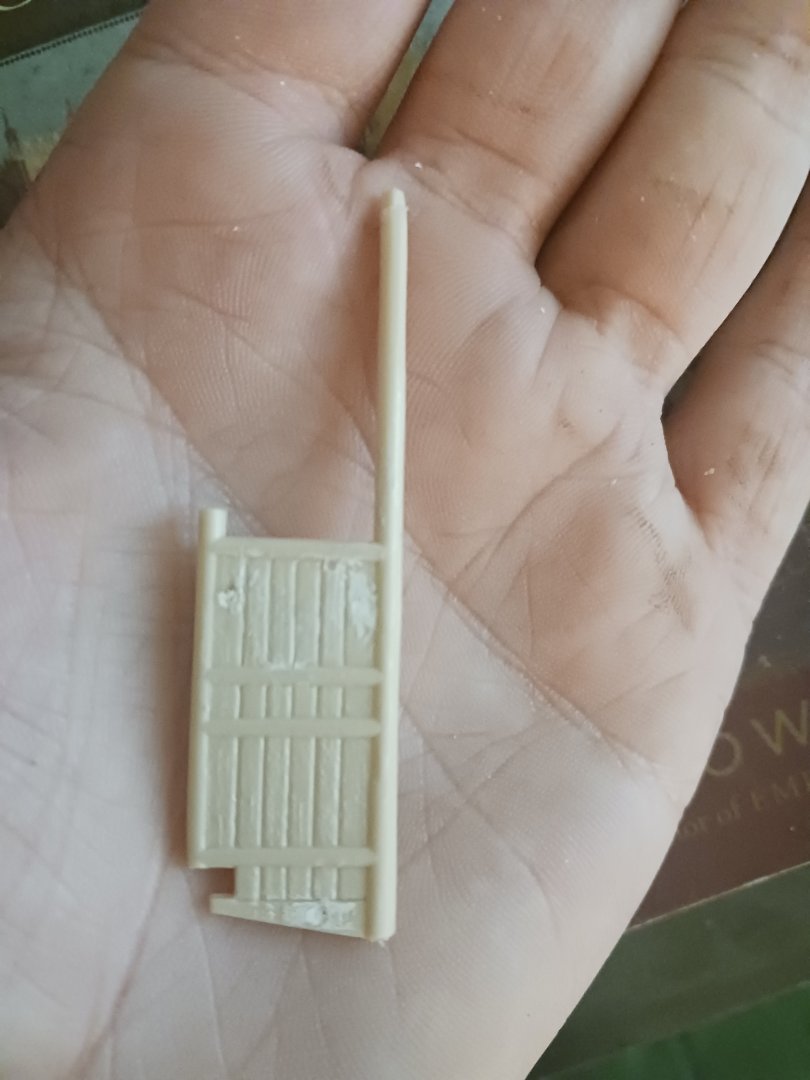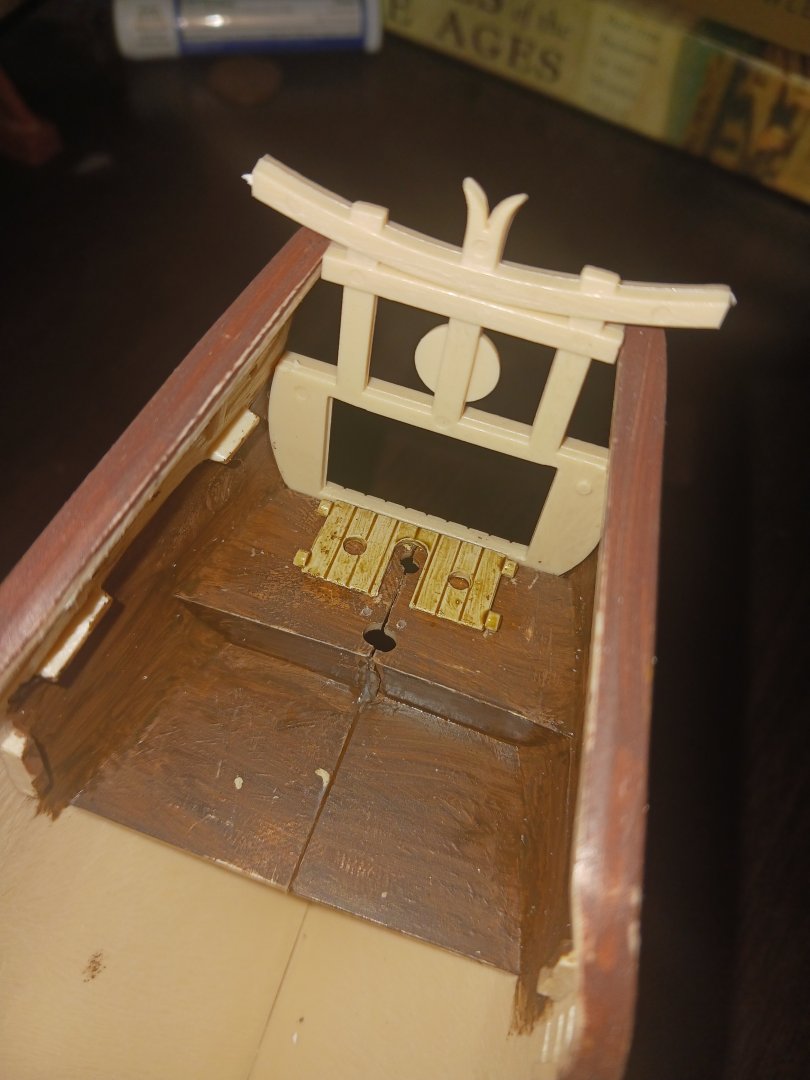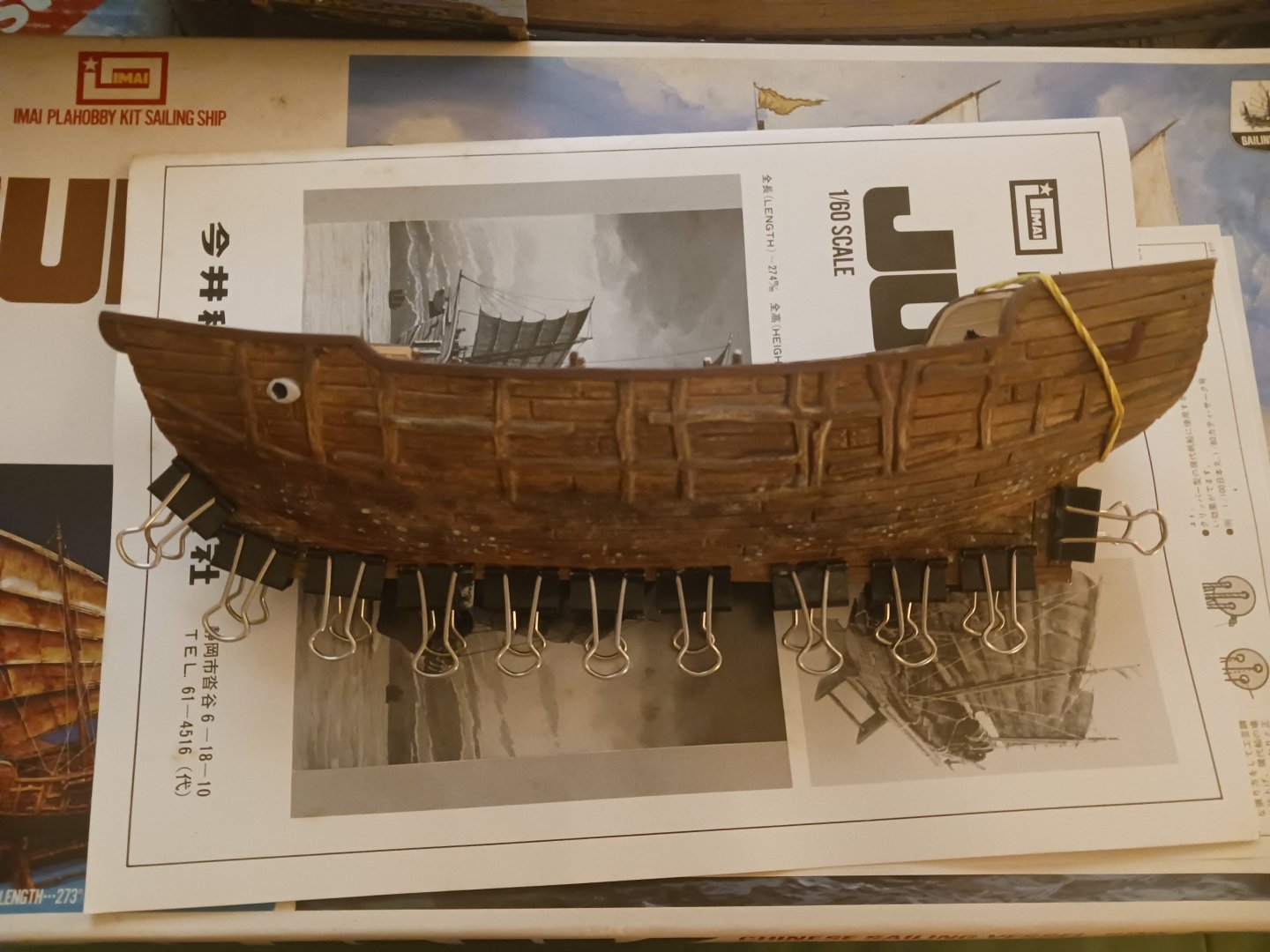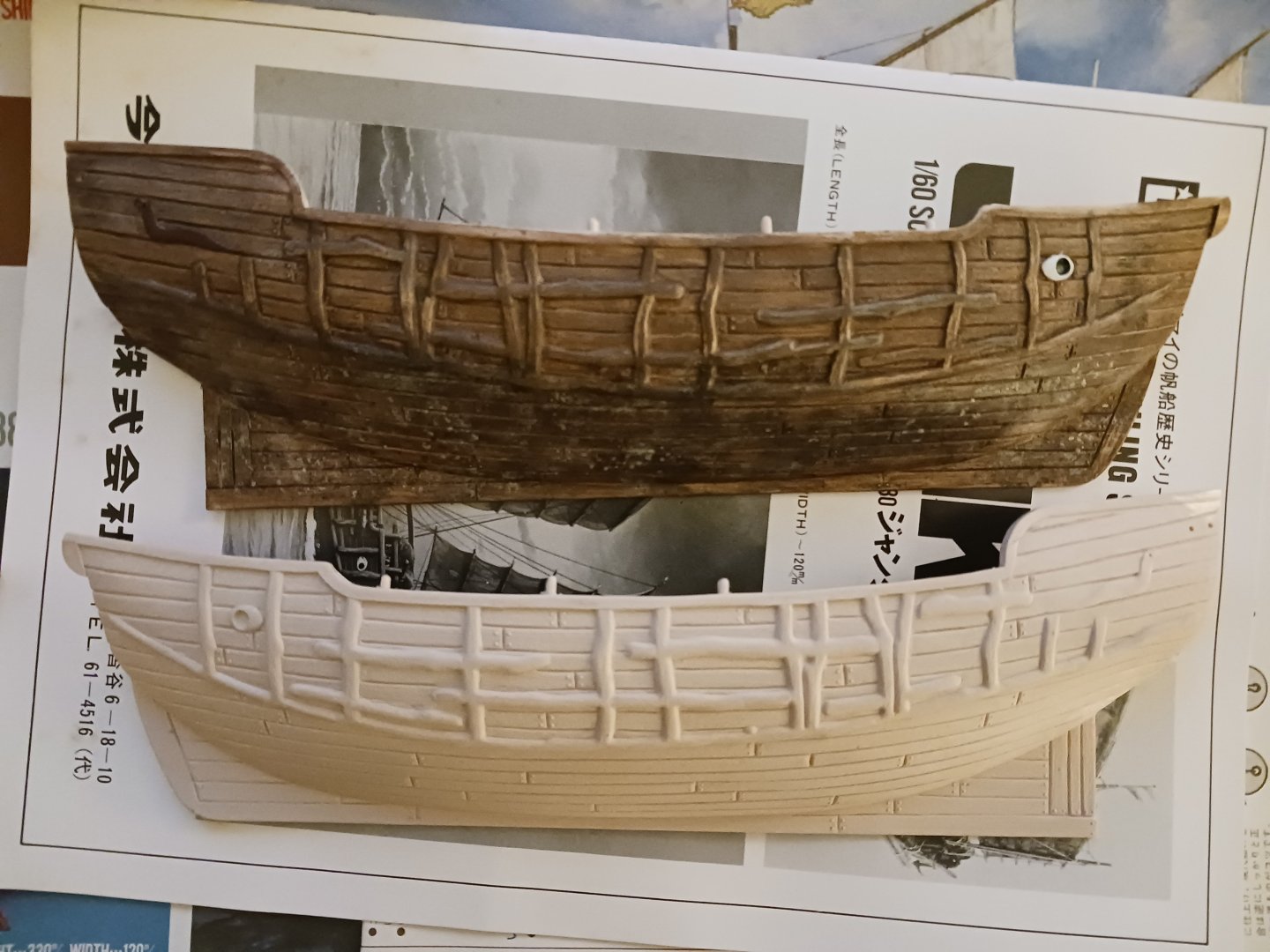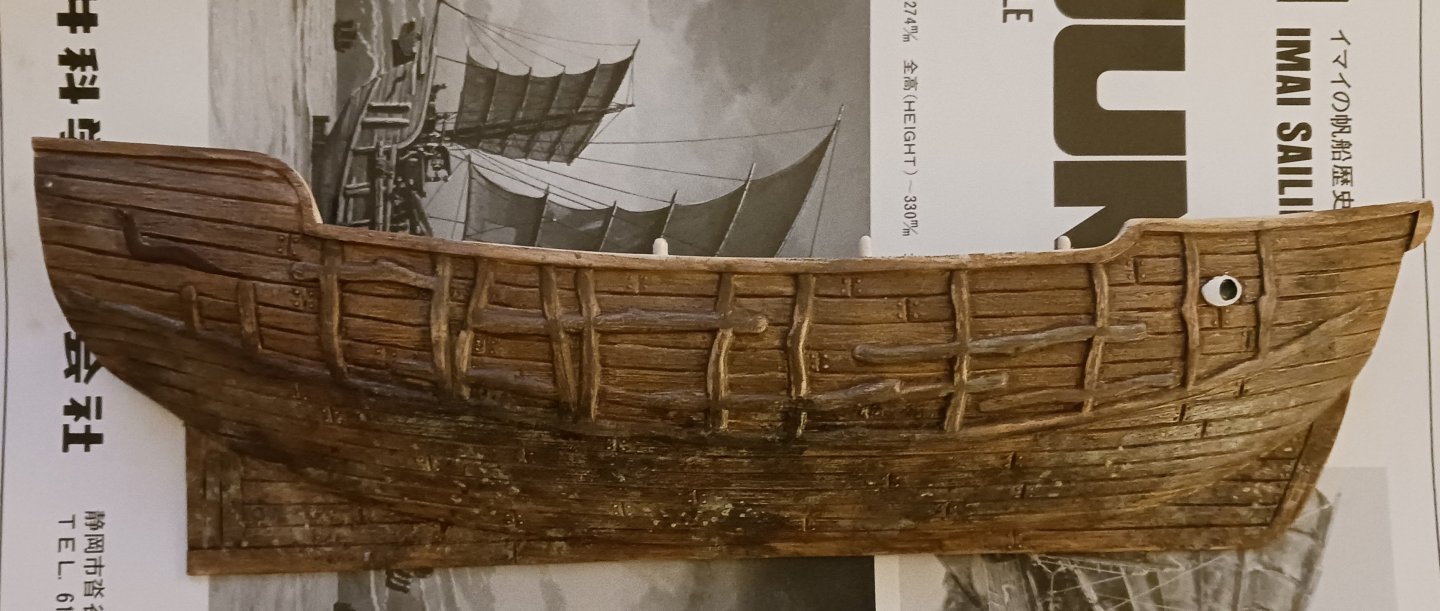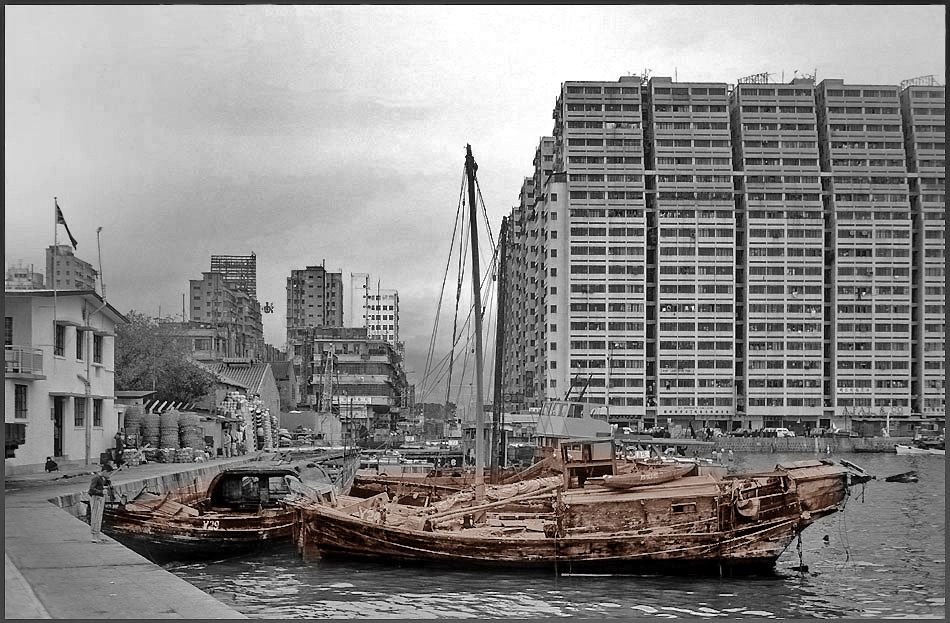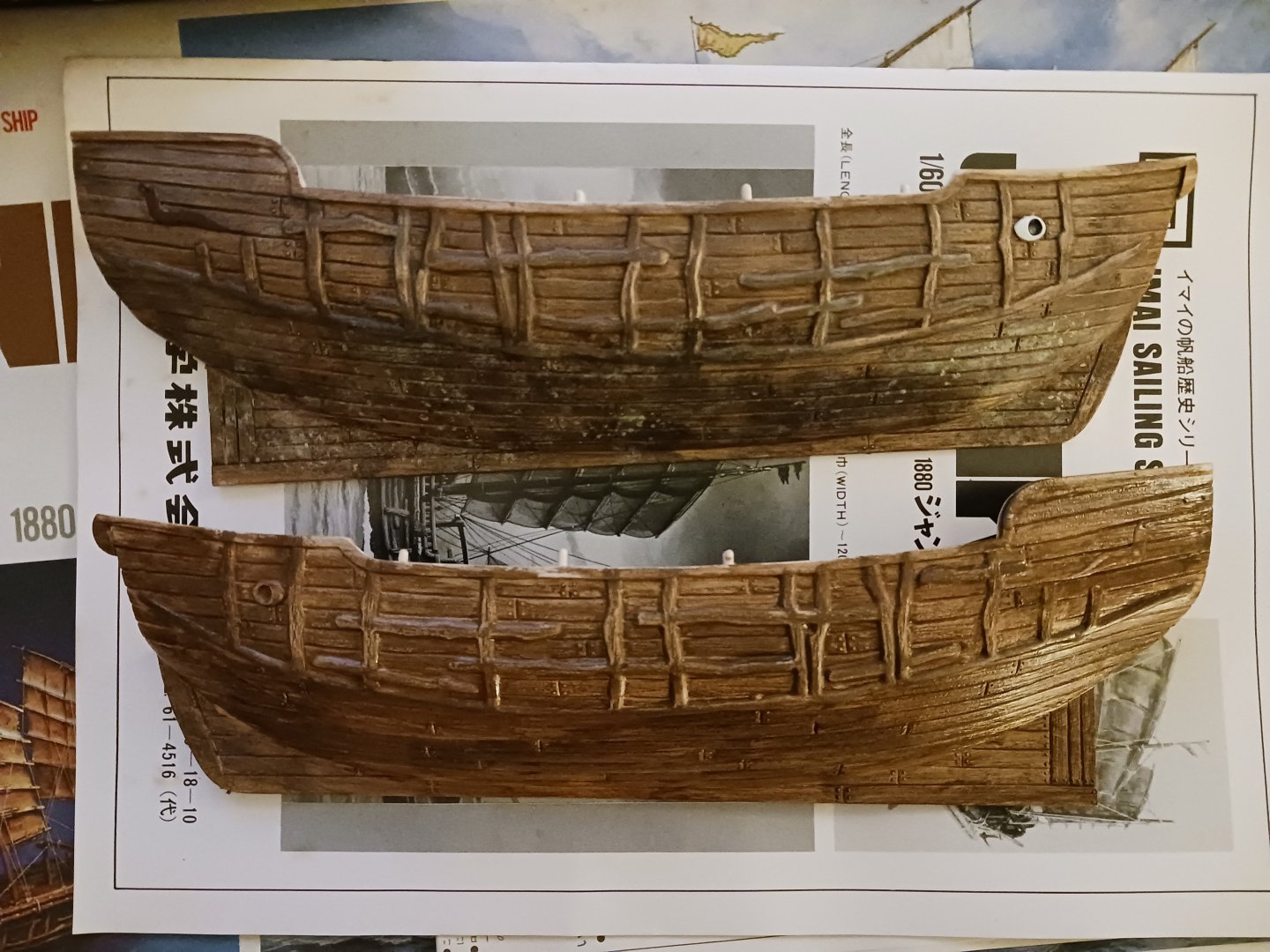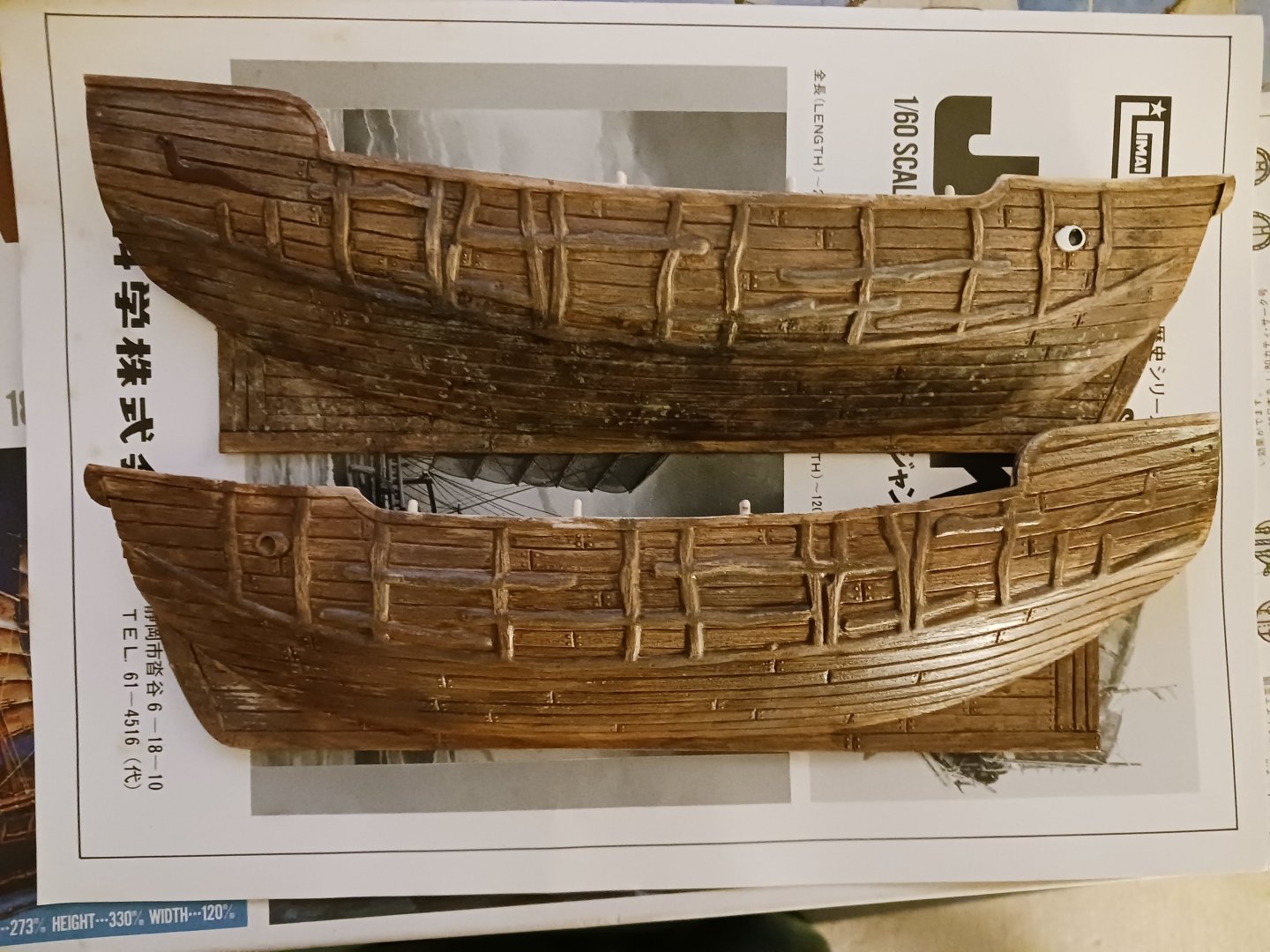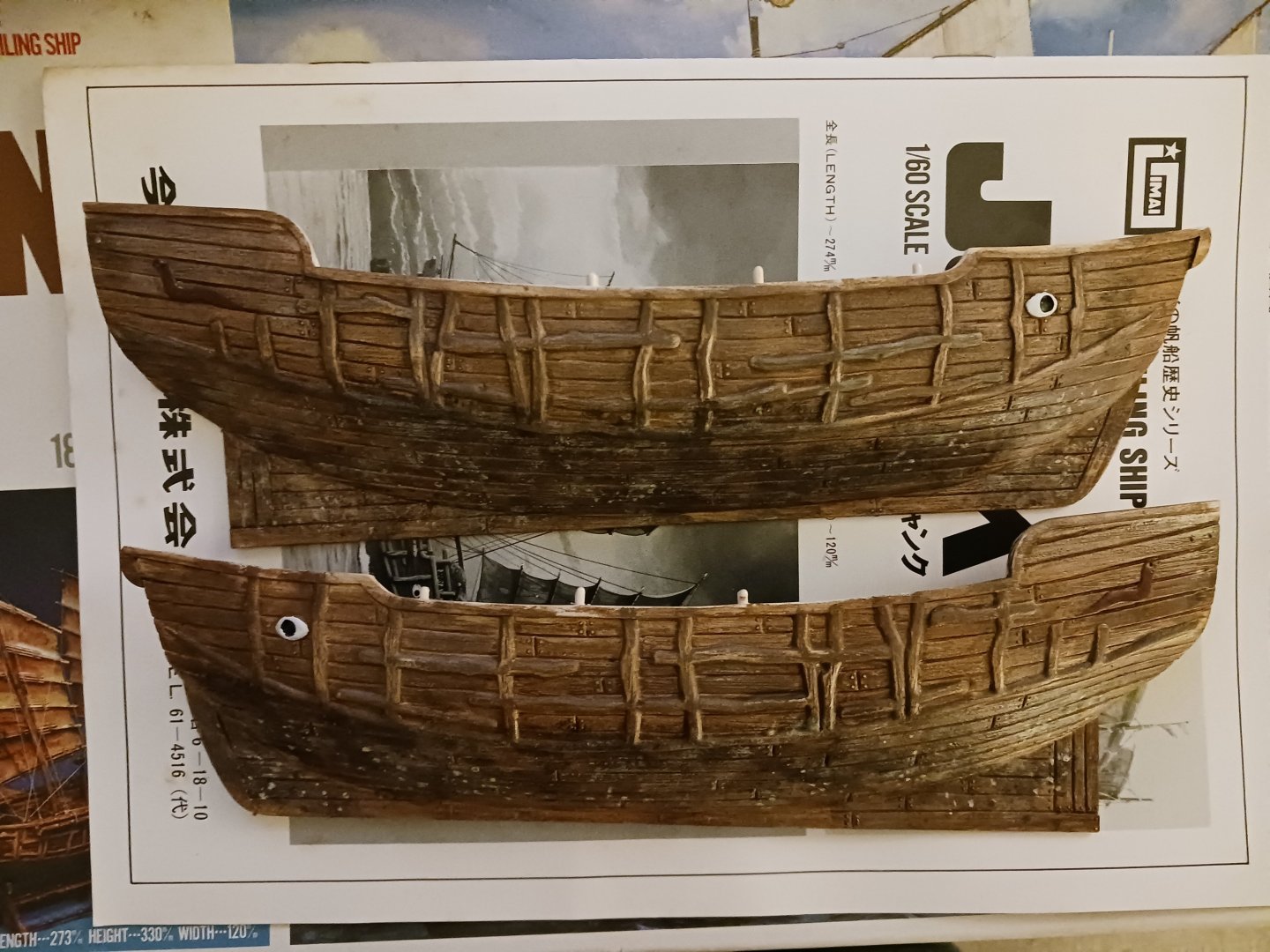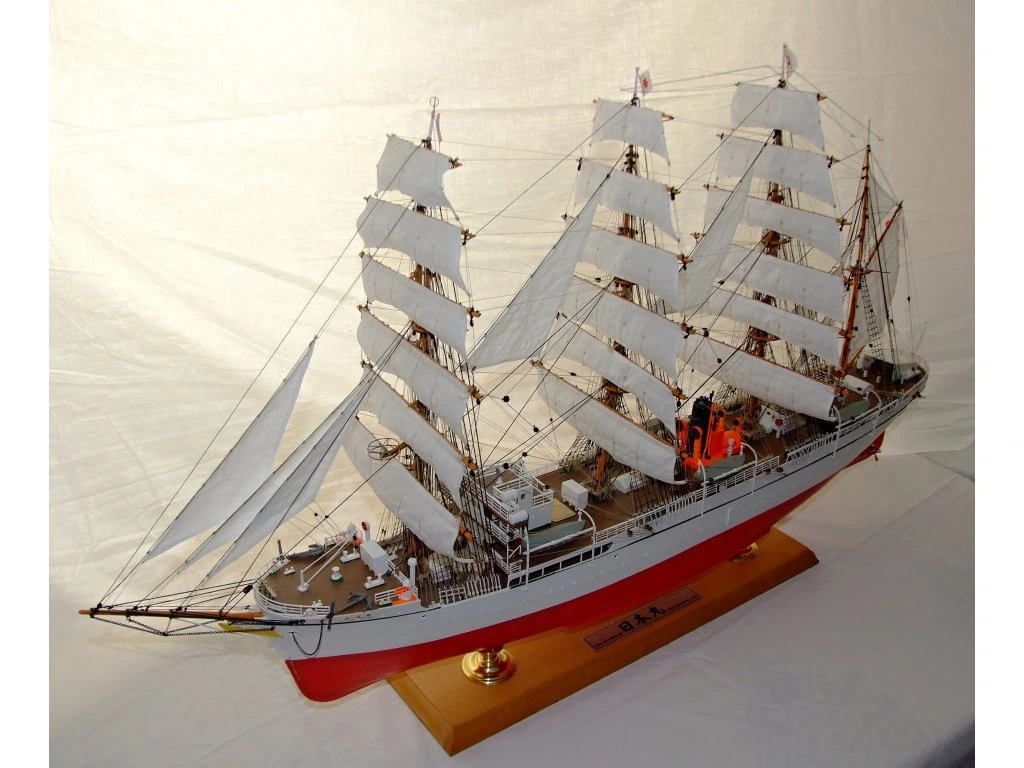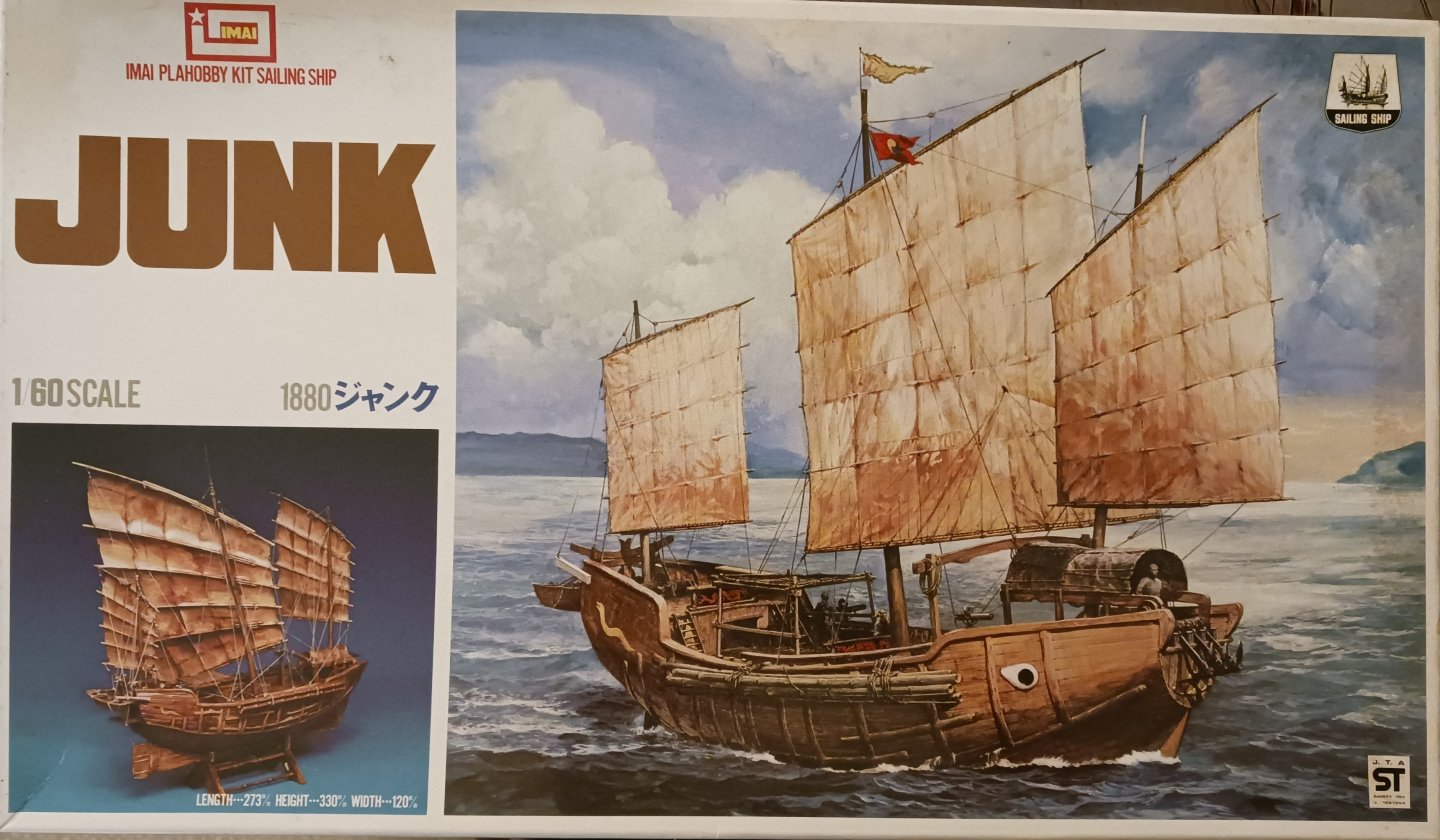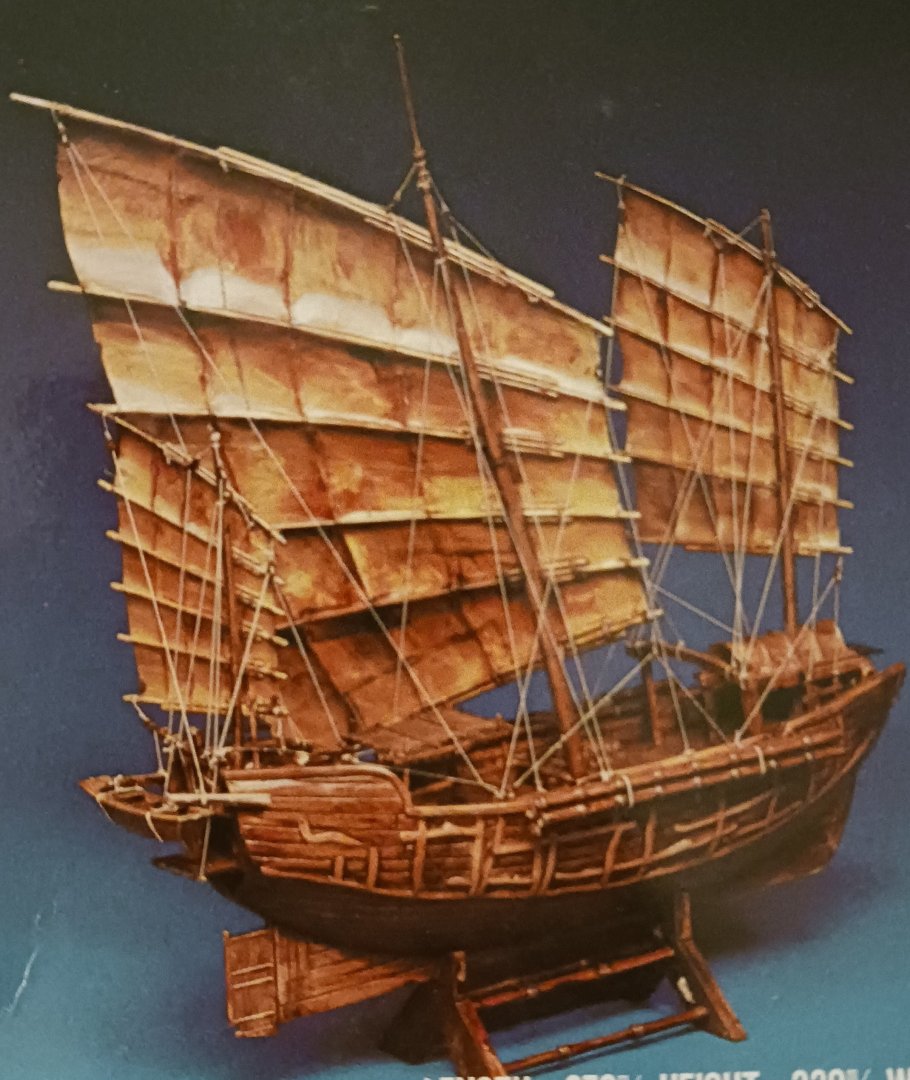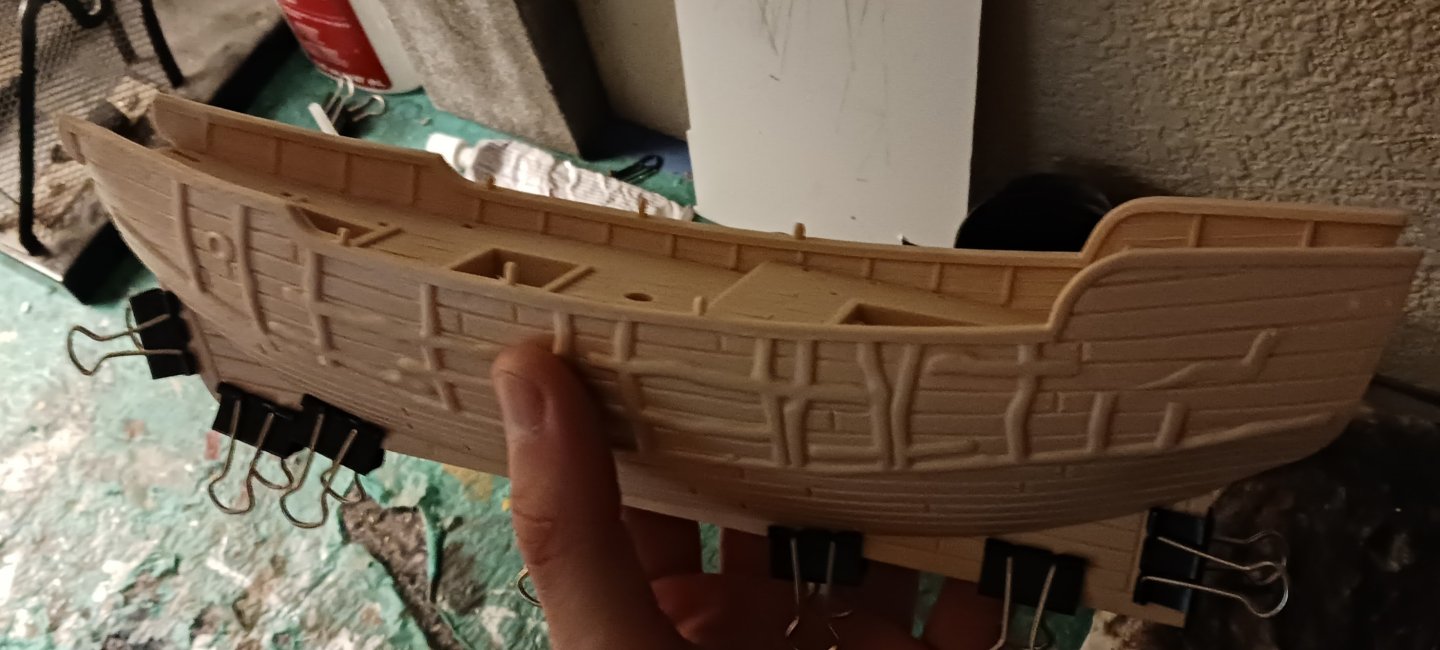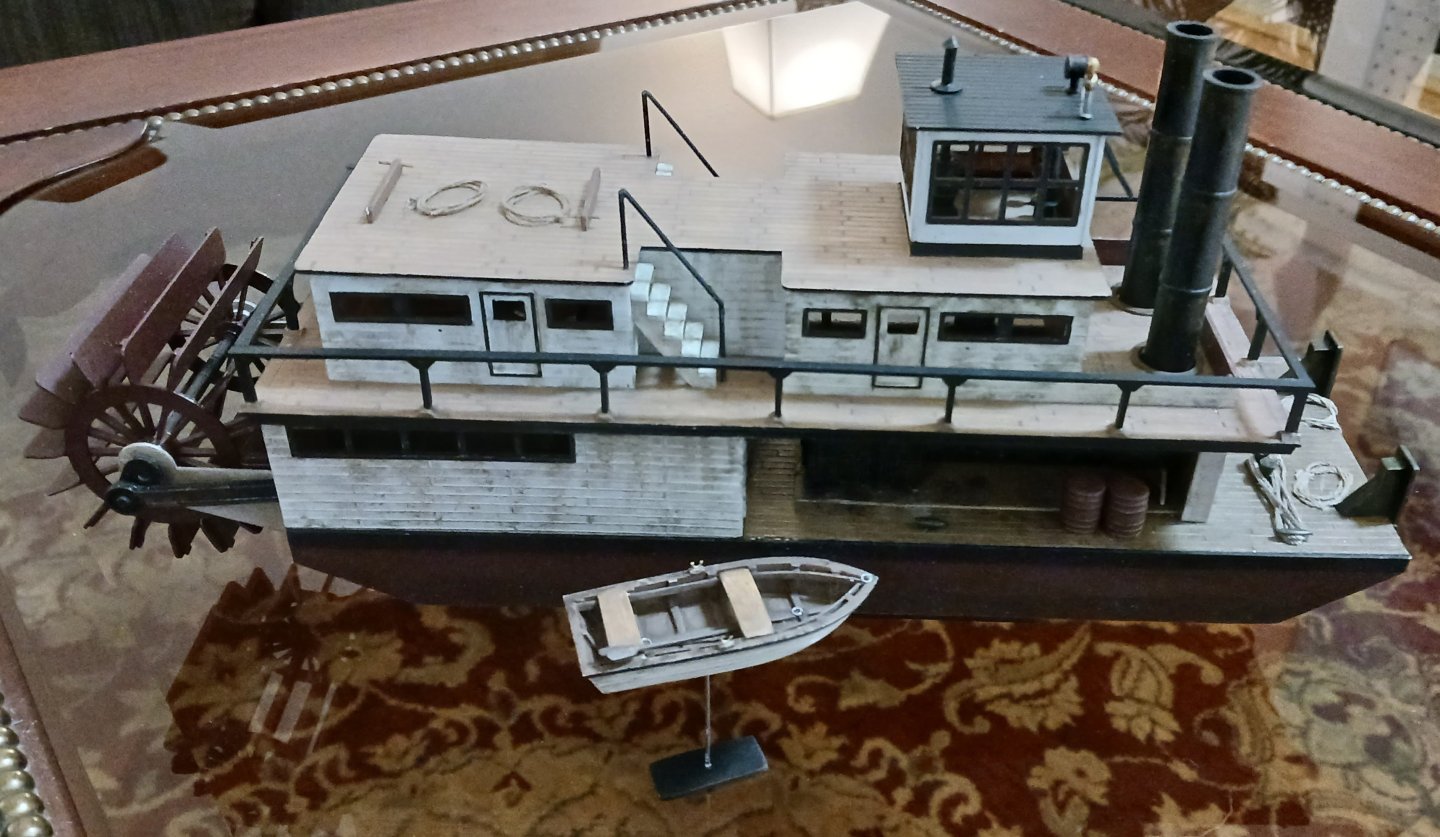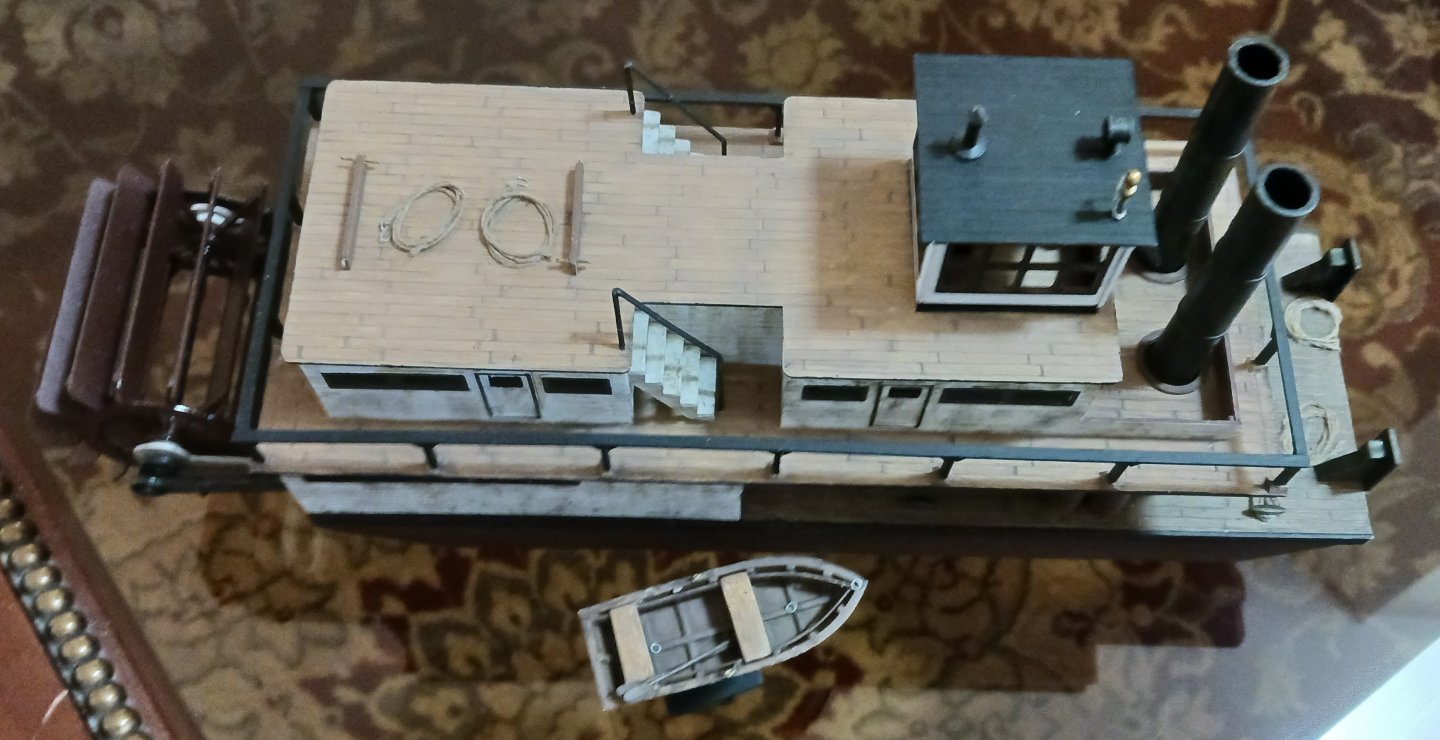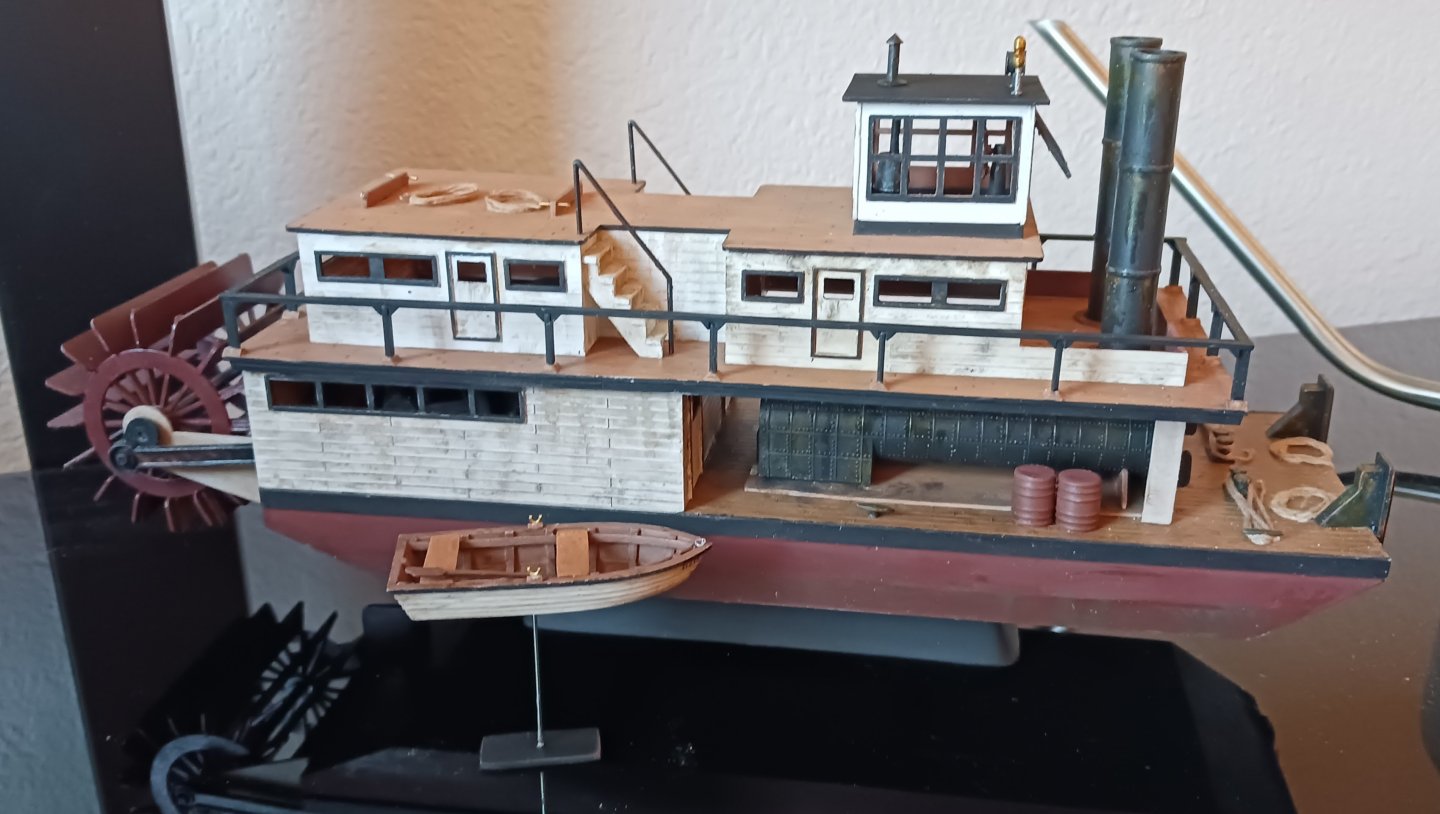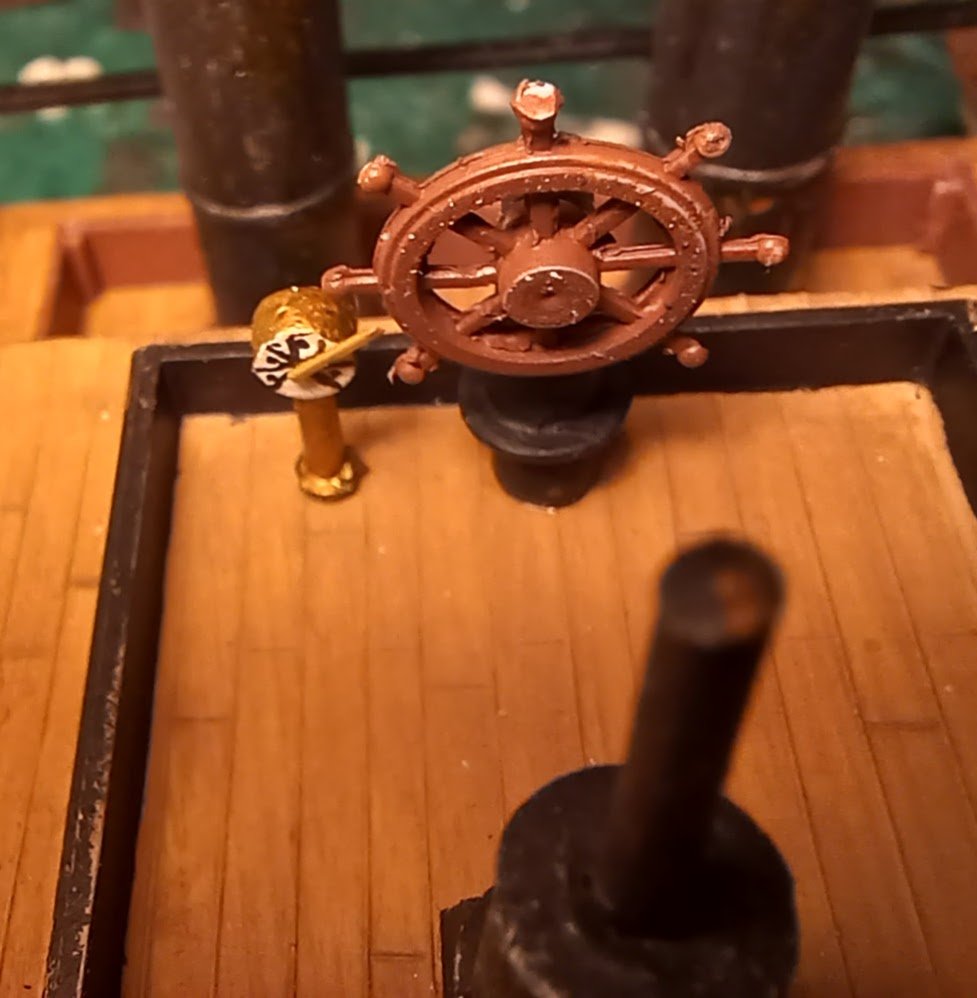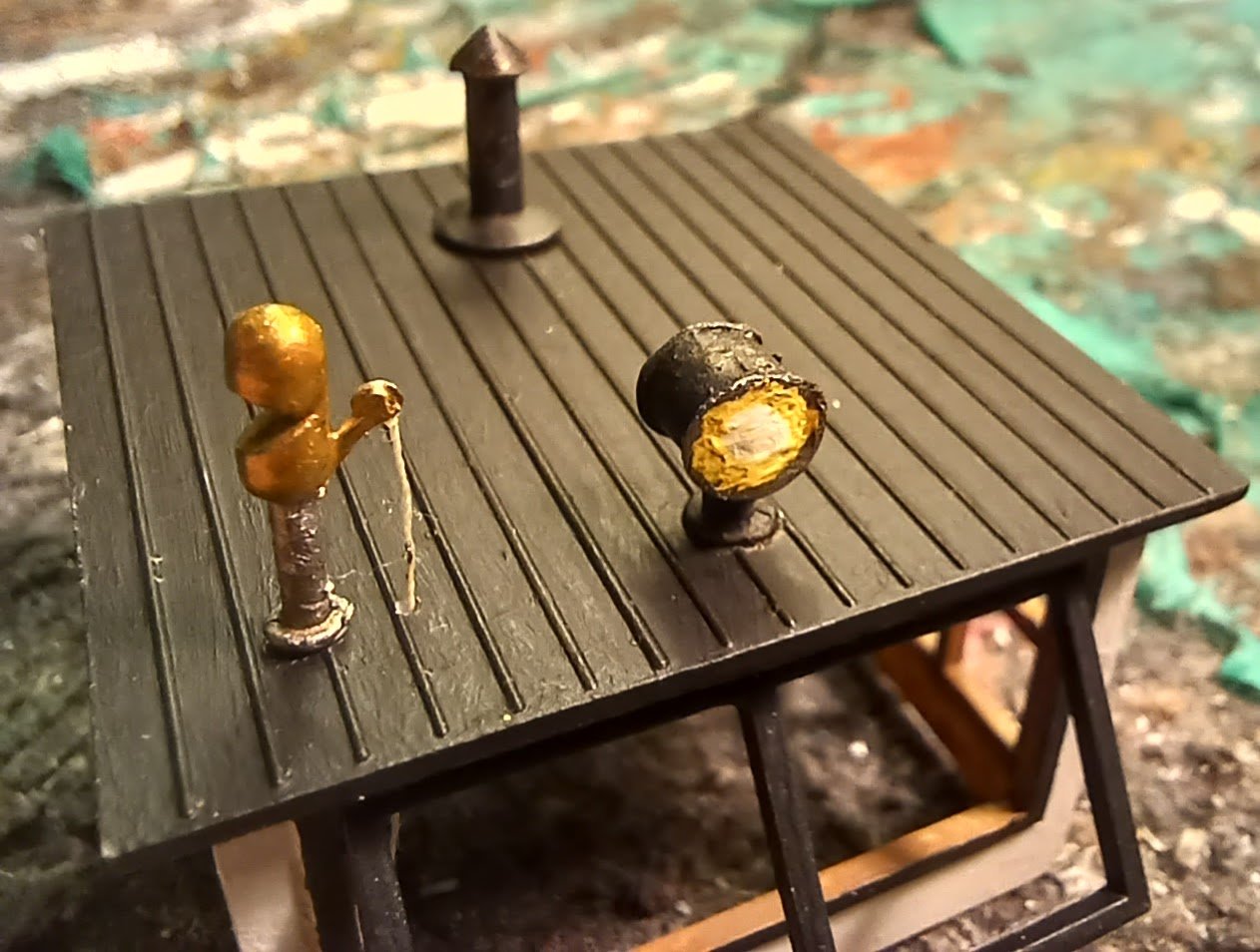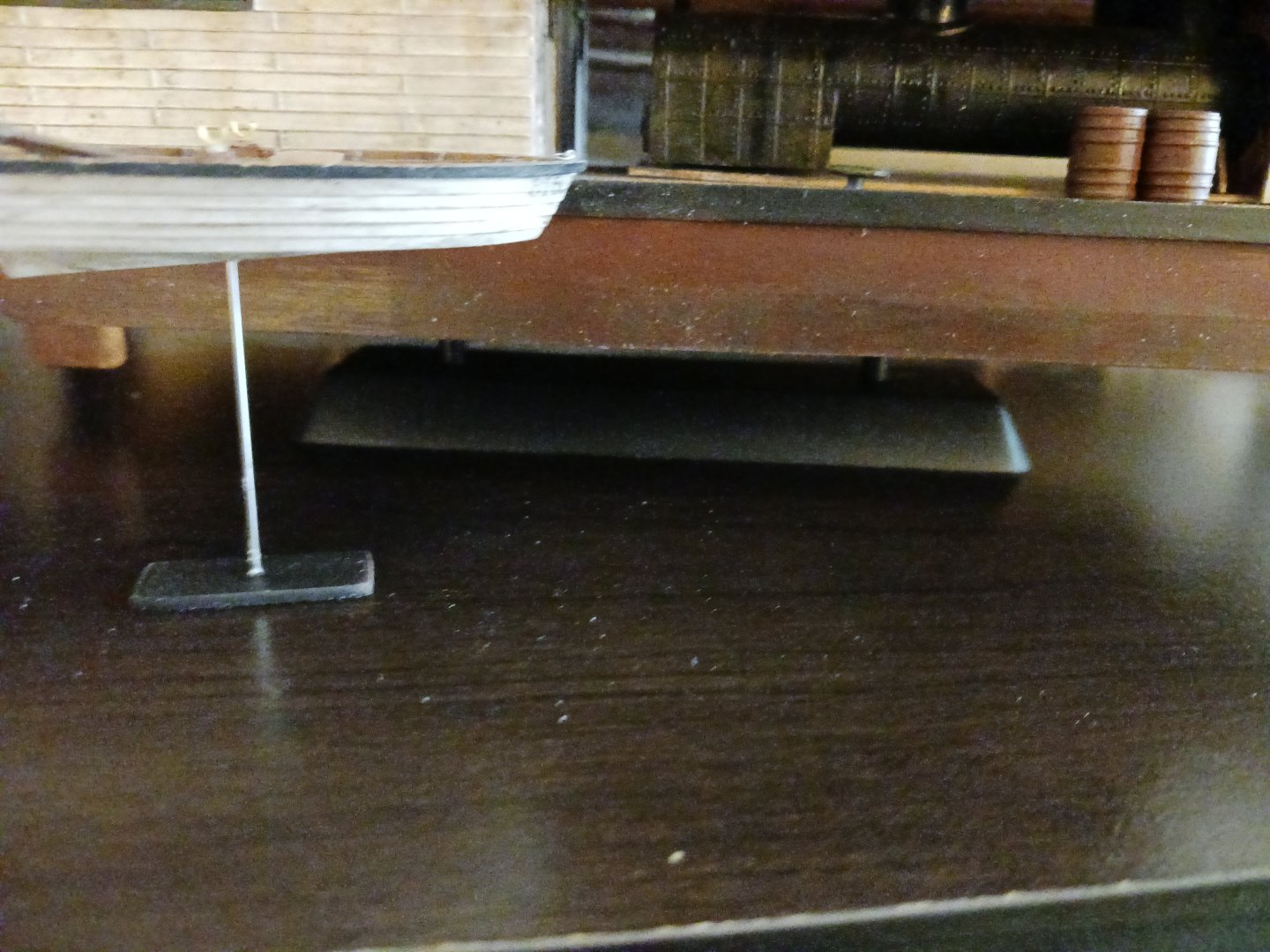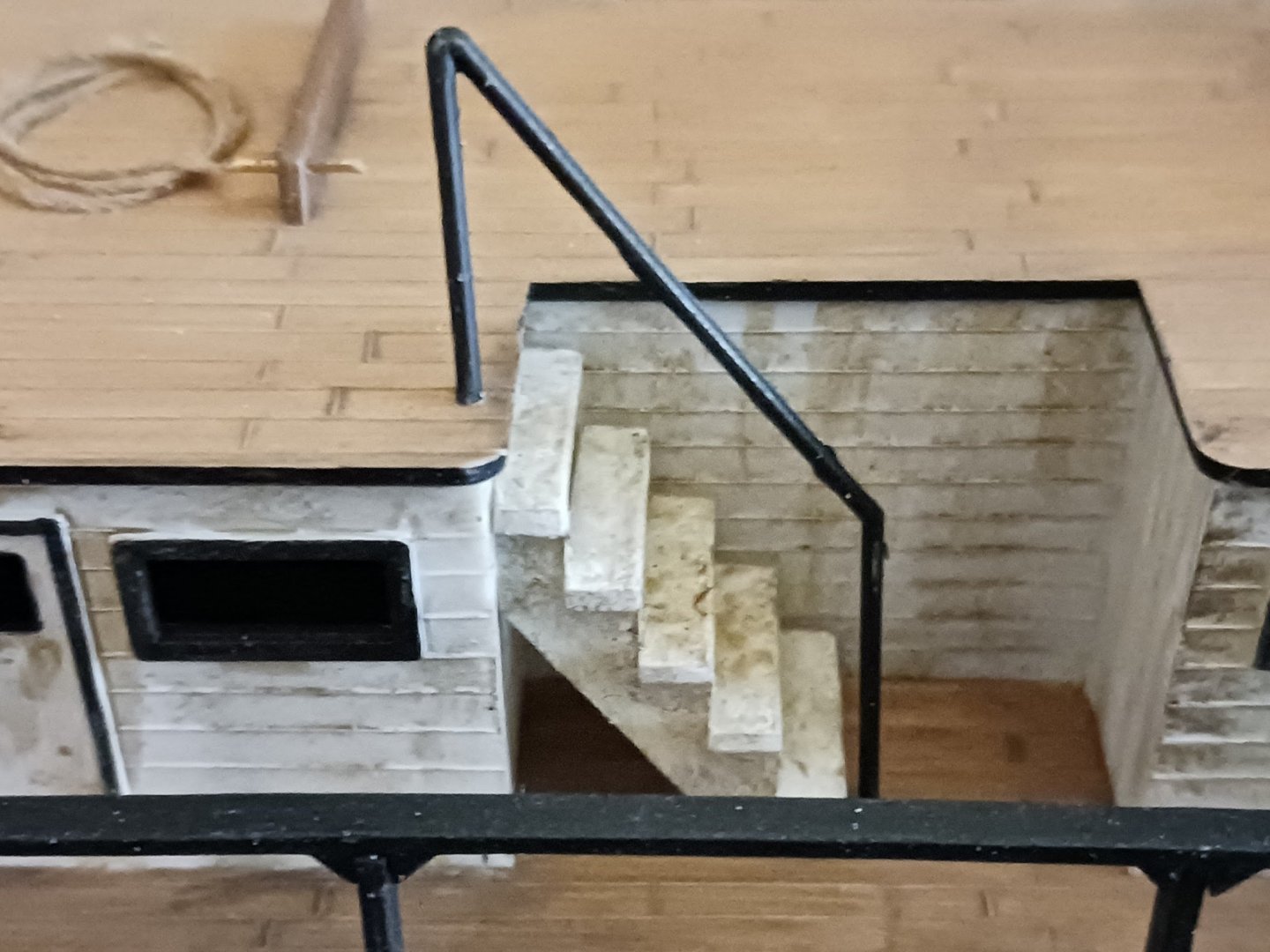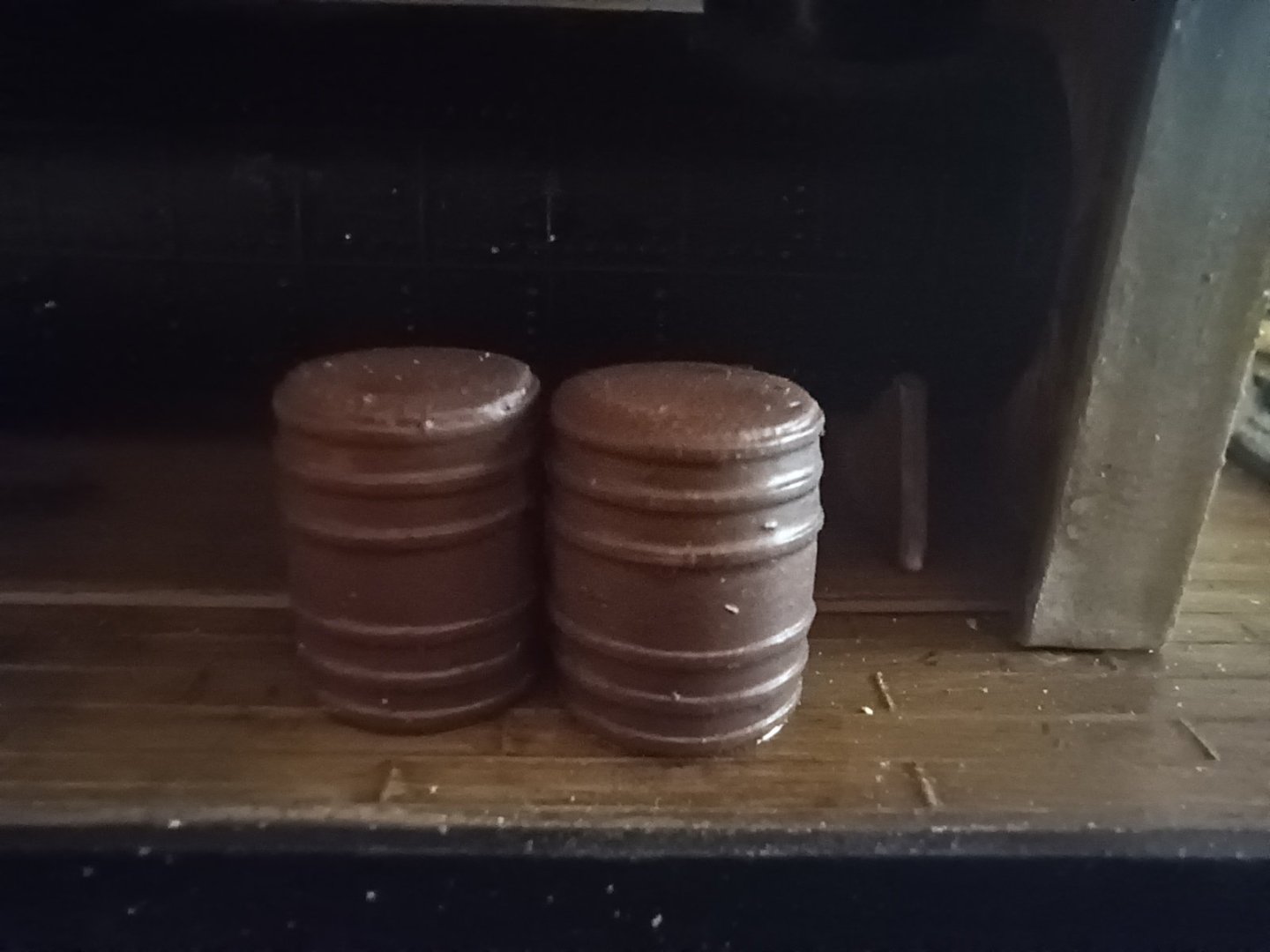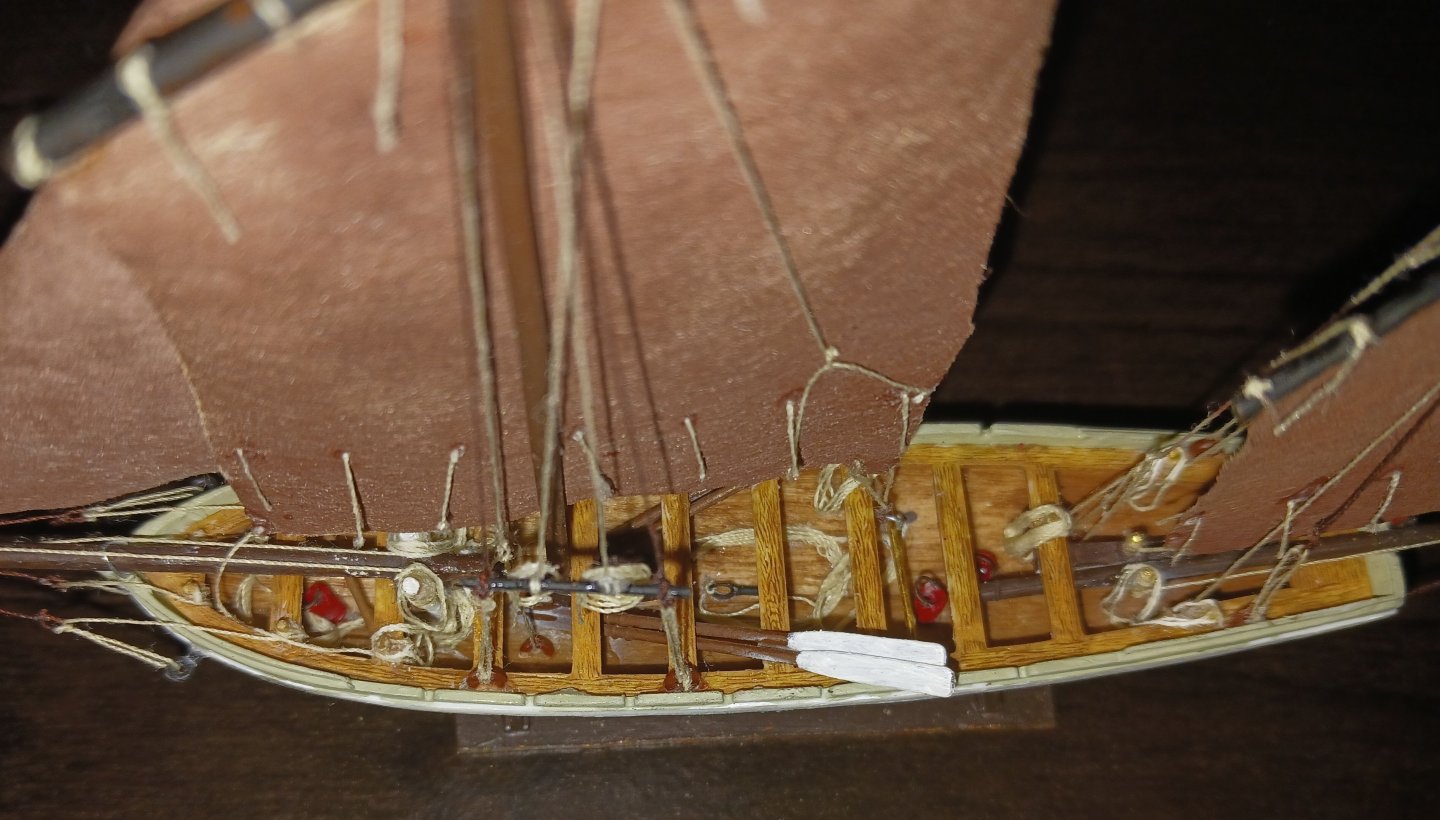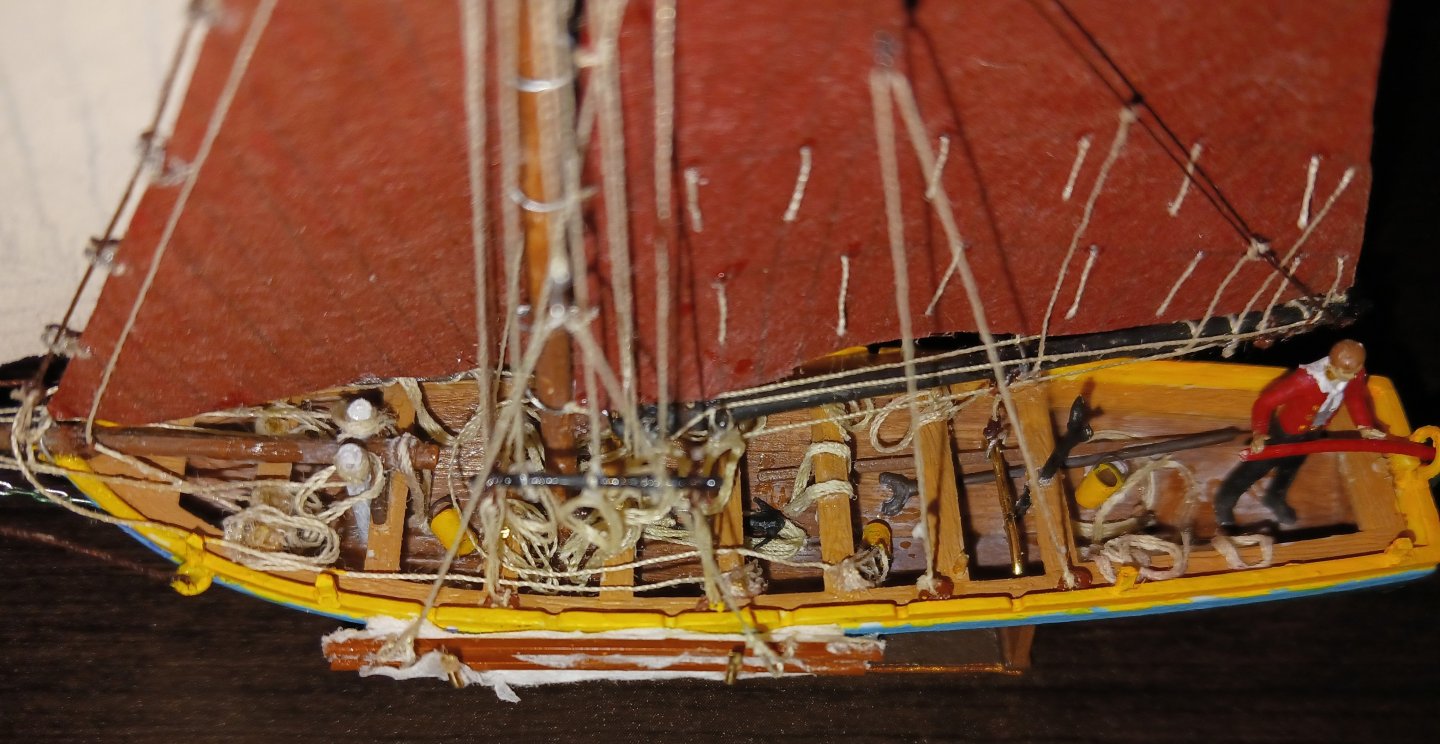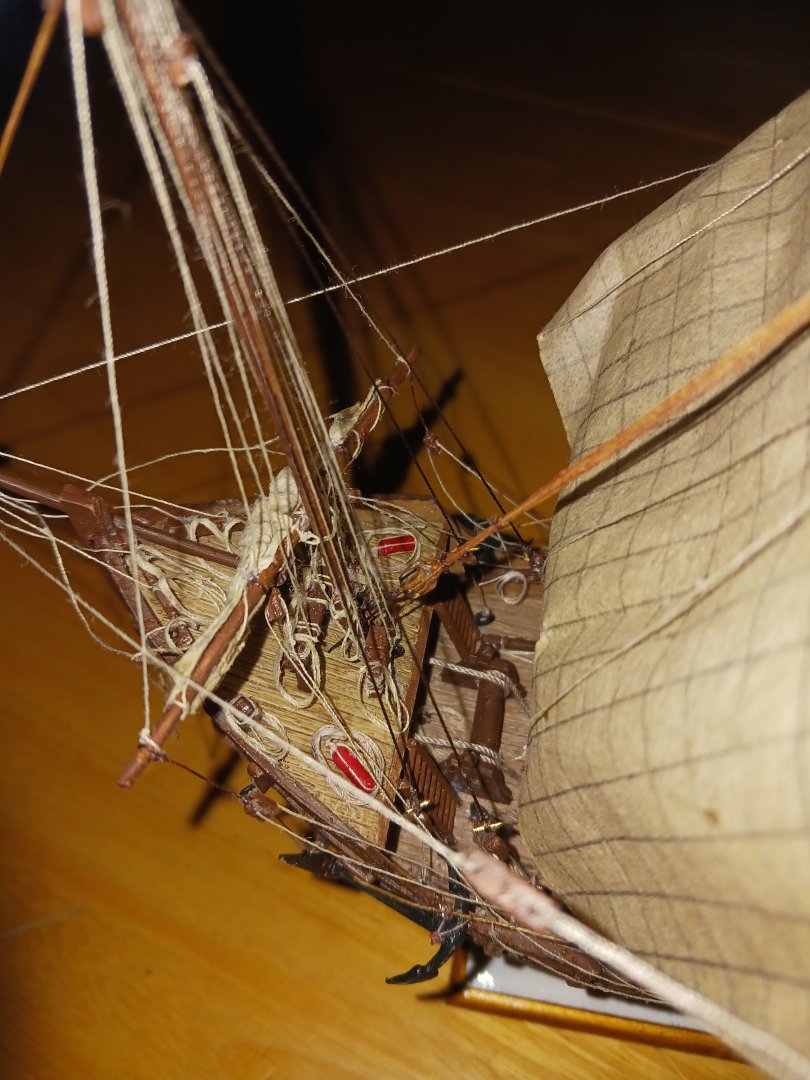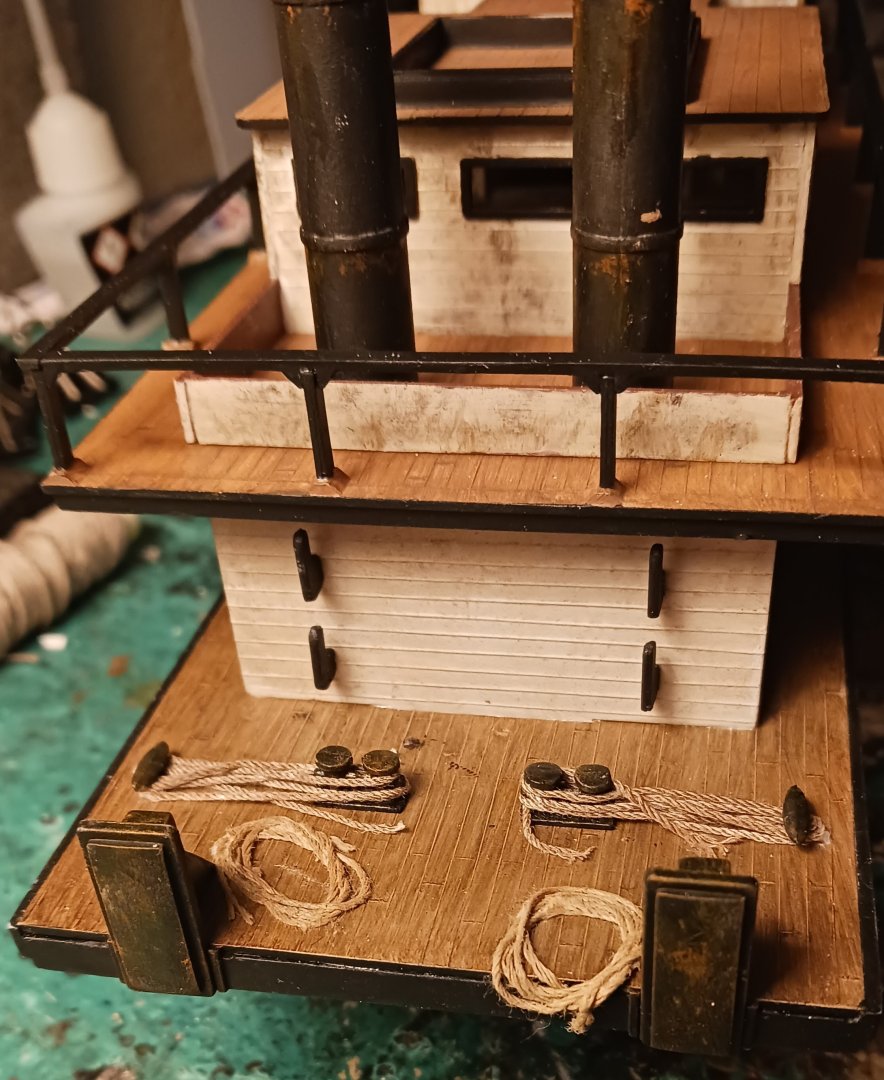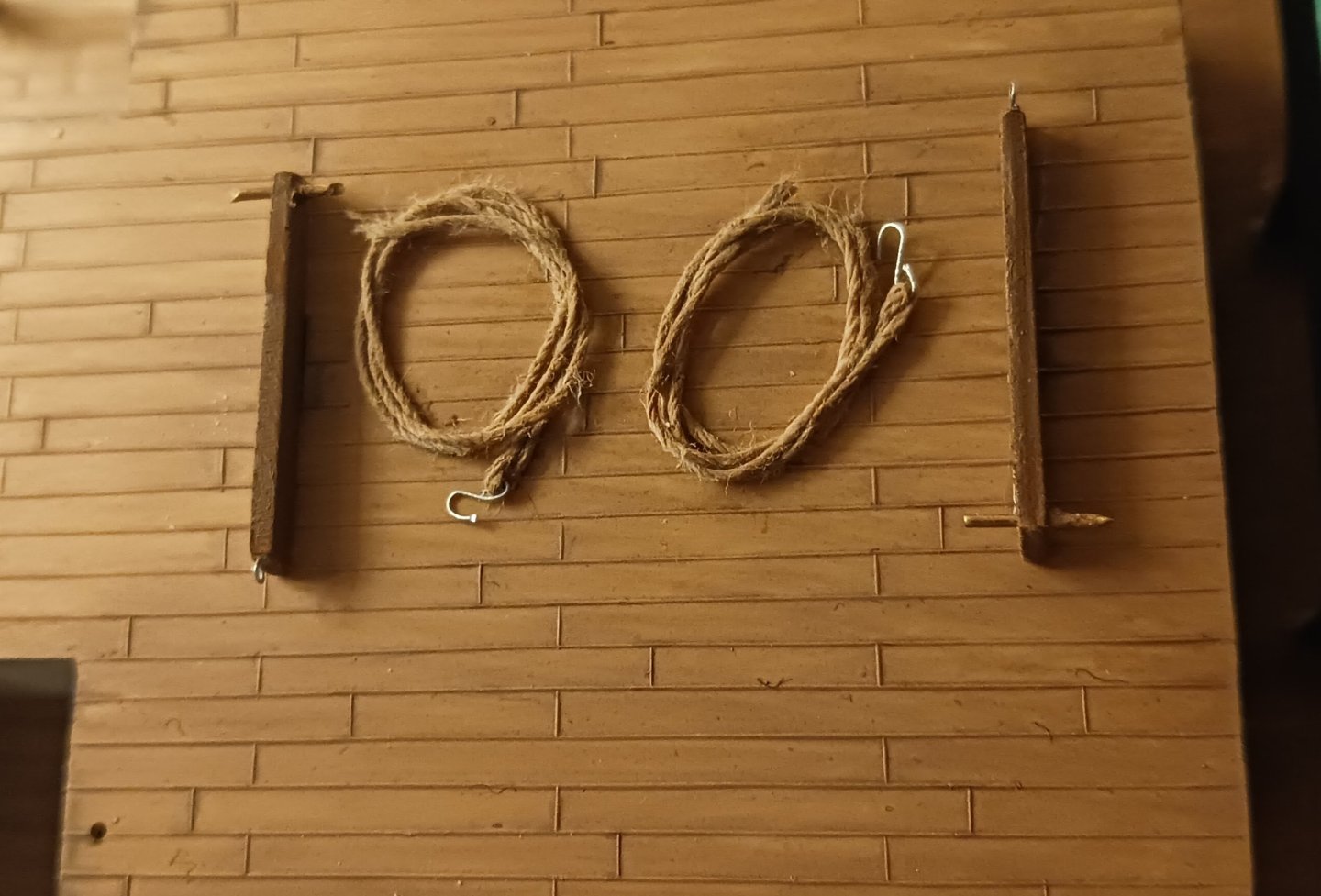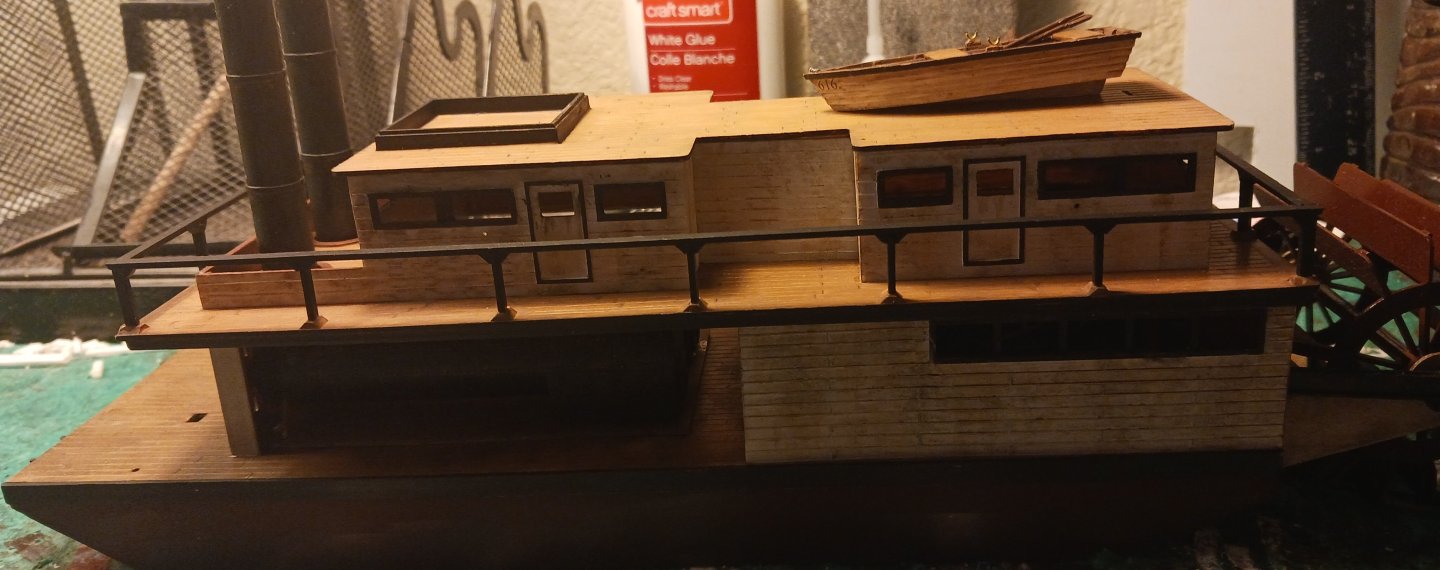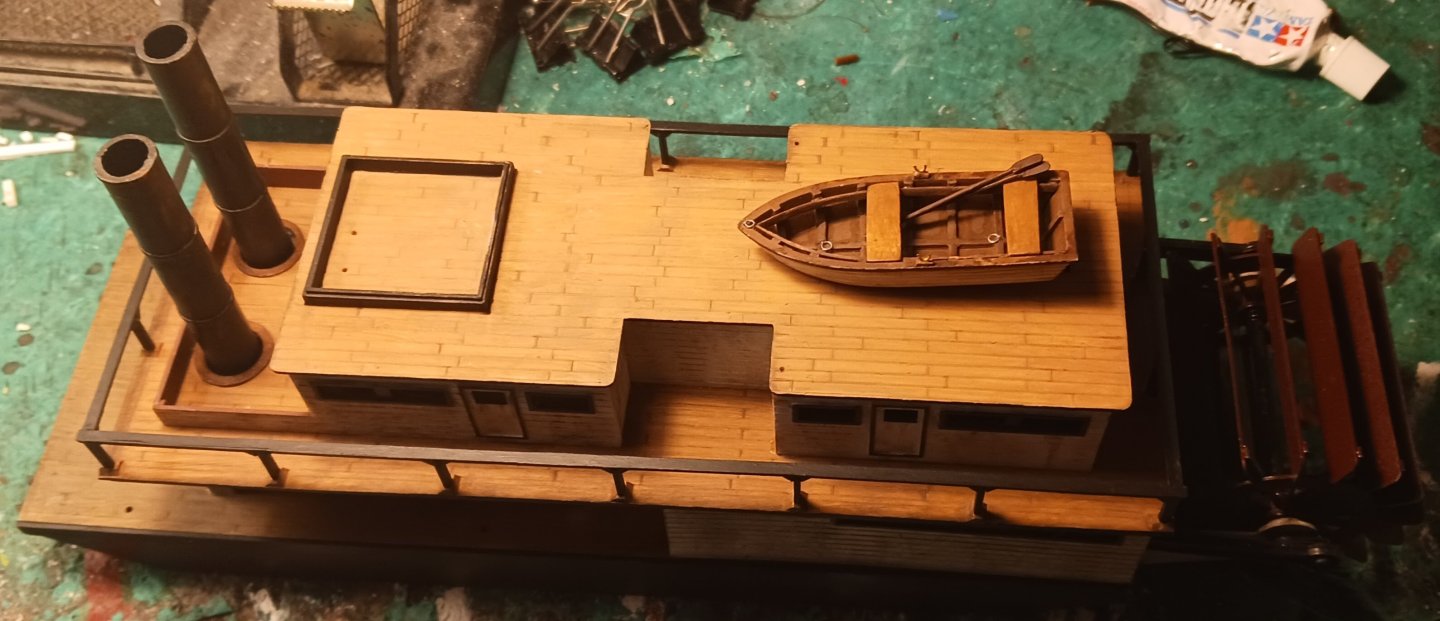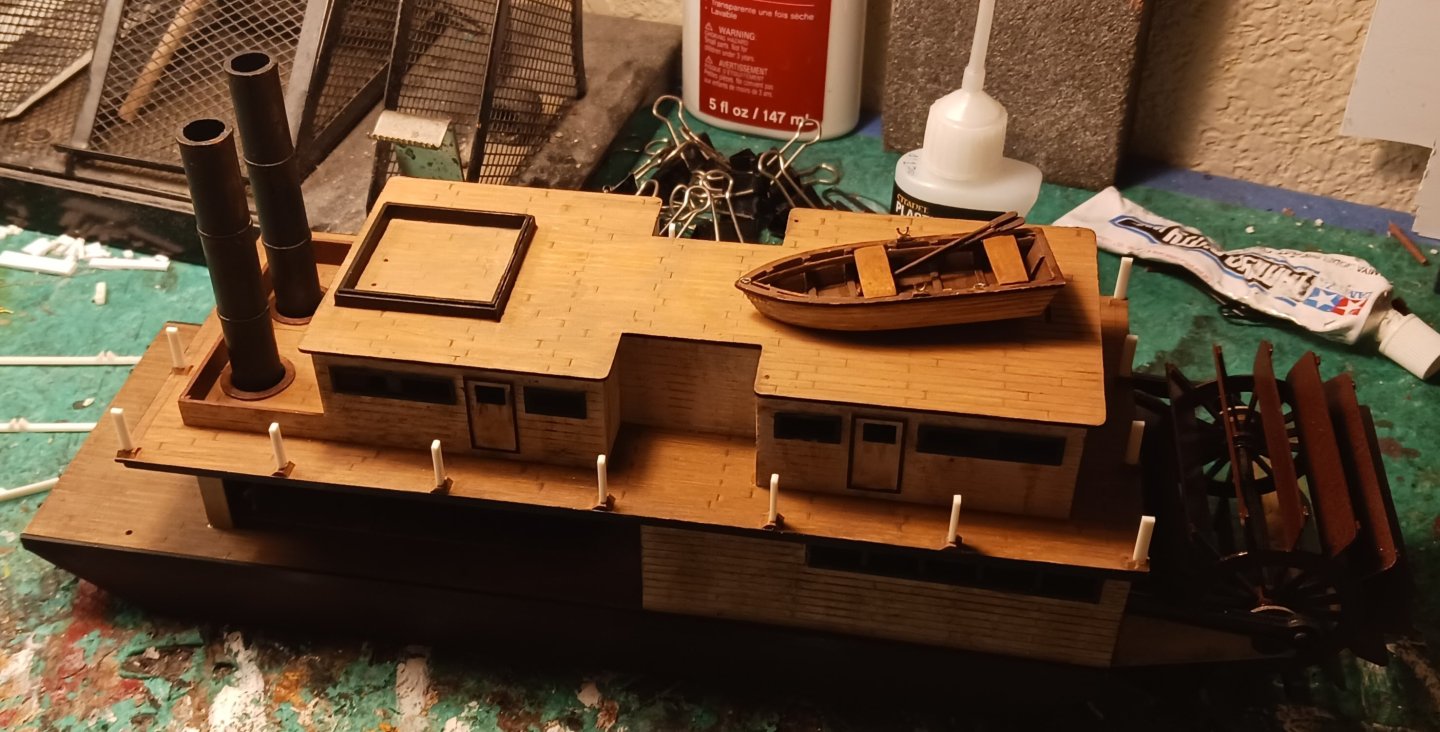-
Posts
1,389 -
Joined
-
Last visited
Content Type
Profiles
Forums
Gallery
Events
Everything posted by Ferrus Manus
-
The next thing I'd like to get out of the way before we do the deck is the rudder. Here is the ship's rudder and tiller: I have already done some modification to the rudder in preparation for mounting. The kit instructions say that you are to trap the rudder between the hull halves when you glue the hull together. I did not want to do that. I wanted to retain the rudder's freedom of rotation and, more practically, delay the installation of the rudder until after the hull halves were glued. Originally, there was a ring that went around the top of the rudder's main post, and two pegs that joined into the sternpost at the aft of the ship. I have sanded both of those down. Rather unusually for Imai kits, there are three injector pin marks to fill with putty. This is the rudder after I filled the injector pin marks. I have also drilled a hole with a pin vise near the top of the rudder fin. This will accept the rudder lift, which was an important feature on Chinese junks: The stern of the ship. I have the unpainted transom resting on the back of the hull. The planked gun platform is glued in place and painted. There are two holes on the center-line of the stern. The forward hole is for the rudder, and the aft is the step for the mizzen mast. I have drilled two holes immediately aft of the rudder hole for the lift. Some actual rudder designs:
-
Gluing the hull halves is very easy given that this is an Imai kit. The keel will require some sanding and the aft interior will receive some more painting detail.
-
This is the paint job for one of the hull halves. I made sure to attempt to accurately portray the way hot, wet climates beat up and destroy wood. Clearly, this junk has not been well taken care of. My decisions for this model's paint job were based primarily on this black-and-white photograph, which I have interpreted in color: Let's see how we got there. First, I applied a coat of cream colored paint, which was almost the same color as the plastic: Then brown on the very organic-looking wales, and a creamy tan on some of the planks, which may have been replaced recently. I made sure to make it as messy and sloppy as possible, which will come in handy when weathering. A healthy coat of a light brown shade: A very heavy coat of antiquing medium, my favorite paint for the last two years: I made sure to rub some of the paint off to add to the weathering effect. I also dry-brushed on a mixture of brown, white and grey, which you can barely see in photos: I then added muck on the bottom, as well as barnacles and algae: Finally, the eye and serpent carvings were painted: This is approximately how we will continue the paintwork throughout the construction of this model. We will pay special attention to weathering and shading, and spend as much effort as possible making this ship look like something that would have really existed in the South China Sea. You should be able to see a clear distinction between this and Aoshima's paint job, which looks toylike in comparison. We will paint the gunwale in a bit.
-
If I ever have the time, money, or display space, I would like to build Imai's Kaiwo Maru in 1/100 scale, a four-masted sail training bark:
-
I've been eyeing this kit for a while, as I would like to build another Imai ship model. I also used to have a fascination with Chinese and other non-Western ship types, which I feel are woefully lacking on MSW. I'm also pretty sure my build of this model is going to be the first on the forum. My build logs usually entail me posting progress photos and maybe a few explanatory sentences, but this one will be a severe departure from that norm. The reason why is that this log is intended to serve as instructional material for a coworker of mine who is just starting out with scale model shipbuilding. Thus, extreme care must be taken to ensure my information is accurate and well-explained. I somehow managed to get my hands on a first-edition copy of this kit, and if you know Imai kits, you'd know how rare they are. Please, if you see one of these for sale online or anywhere else, snatch it up right away- you may never see one again. There are Imai kits I have been searching for for years, and I've never found even one place where they were sold. Here are some introductory photos: The first two pictures are of the box, and the third one is of the instructions, which are all in Japanese (Imai is a Japanese manufacturer that is long-defunct). You might see an issue when comparing the three. The two illustrations of the ship have significant differences between the two, which in turn have differences between them and the model itself. For those reasons, and reasons of historical accuracy, I am going to rig my model based on historical photos and diagrams. The hull will be constructed according to the instructions. This is Aoshima's version of the model. The model has a lot to be desired in the paint department, and while the plastic sails provided in the kit are some of the best I have ever seen, they are still plastic sails- woefully out of scale, inorganic, and unsuitable for use. I will be replacing them with sails made from silkspan and wooden dowels. There is one more striking issue with the kit that is obvious in this photo, which is the extreme aft rake of the mast. I have already begun working on a solution for this as far as my model is concerned. I will also be using the ship's hull as a canvas for some pretty intricate paint-work, in order to make the ship look filthy and worn-out. Here's the dry-fitted hull and deck: Wish me luck!
-
Next will be Imai's Chinese Junk, which is currently sitting atop my stack of boxes. I have not started yet. Currently doing some research.
- 56 replies
-
- Lindberg
- sternwheeler
-
(and 1 more)
Tagged with:
-
It doesn't look like anything amongst the rest of my navy, because it doesn't sit amongst my navy. I built it for an elderly friend from church who I have become good friends with. Her name is Carol, after whom the ship was named.
- 56 replies
-
- Lindberg
- sternwheeler
-
(and 1 more)
Tagged with:
-
- 56 replies
-
- Lindberg
- sternwheeler
-
(and 1 more)
Tagged with:
-
Throughout the previous two days, I have put some barrels on the deck, made and furnished the pilot house, made the stairs and their railings, and made and painted the ship's and boat's stand. I tried to paint a convincing speed gauge, and dealt with the fact that one of the wheel's spokes broke off. All the parts for the pilot house were absolute crap, but I made do.
- 56 replies
-
- Lindberg
- sternwheeler
-
(and 1 more)
Tagged with:
-
@wefalck And safety wouldn't have been the #1 priority for people the likes of which would have crewed Lula. On an ocean-going Man O' War, your logic applies perfectly. However, that logic kind of falls apart when you get into the local working boat scene. Is Lula on a resupply run currently, or is she docked in a quay? Does her crew really care that much about safety, or rather speed?
- 732 replies
-
- Lula
- sternwheeler
-
(and 1 more)
Tagged with:
-
Try making it look a bit like this: Obviously, without the ugly CA stains that appear in flash photography. What I try to do is think of every single little piece of equipment a ship could possibly need, and pile it as haphazardly as possible on the deck.
- 732 replies
-
- Lula
- sternwheeler
-
(and 1 more)
Tagged with:
-
As she should! Most work boats did, in some way.
- 732 replies
-
- Lula
- sternwheeler
-
(and 1 more)
Tagged with:
-
On a related note, this is an Essex work boat from the early 20th Century: I would tell you to add every single thing that comes to mind. Image removed by moderator (image from commercial stock photo site)
- 732 replies
-
- Lula
- sternwheeler
-
(and 1 more)
Tagged with:
-
@Keith Black WOW!! I got mine for about 30 bucks!
- 56 replies
-
- Lindberg
- sternwheeler
-
(and 1 more)
Tagged with:
-
But hey, at least it doesn't give you cancer as well. Oh wait, it might. Quitting the behavior that's killing you is always a smart decision. Just keep up the fight.
- 732 replies
-
- Lula
- sternwheeler
-
(and 1 more)
Tagged with:
-
- 56 replies
-
- Lindberg
- sternwheeler
-
(and 1 more)
Tagged with:
-
Keith, I am immensely proud of you for your decision to give up smoking. It will vastly improve your quality of life and your overall health as well. Keep up the good work.
- 732 replies
-
- Lula
- sternwheeler
-
(and 1 more)
Tagged with:
-
Today, the railings went in. Tomorrow I will work on the miscellaneous fittings. So far, I have been able to keep the "white and black" color scheme pretty spot on for how I wanted it to look. This scheme is based on @Keith Black's Lula.
- 56 replies
-
- Lindberg
- sternwheeler
-
(and 1 more)
Tagged with:
-
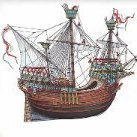
Plastic modeling for the complete beginner
Ferrus Manus replied to Ferrus Manus's topic in Plastic model kits
I have found that the wood model ship scene (as a more challenging medium for a total beginner, but easier than advanced-level plastic modeling) has far more and far better beginner kits than the plastic scene. A great example that comes to mind is Model Shipways' beginner set, with the Dory, Pram and Lobster Smack. -

Plastic modeling for the complete beginner
Ferrus Manus replied to Ferrus Manus's topic in Plastic model kits
I wanted to start him off with plastic kits, as that is the skill set I have and can help him with. I am aware of some of Heller's smaller boats, the ones that come to mind right now are the Sinagot and the Kurun. I have never managed to find a place where the Kurun was available online, for one thing. That leaves us with the Sinagot. I have seen several build logs for the Sinagot, and there are multiple listings on eBay. I have also done some research on French working luggers, and I can say that Heller's Sinagot would need a considerable amount of modification/scratchbuilding to look halfway decent. I am searching for something that he could build relatively easily out of the box. I have found that some of the modern-ish cruising yacht models made by Japanese manufacturers like Otaki are available, and they are extremely varied. They seem to be of a decent quality and relatively easy to build. I may at some point buy myself one of the more complex ones for a fun little project, who knows. -
Keith, I am glad that your doctor is not worried about your condition. Moving forward on the steamboat. I have gotten the upper works painted and glued into place, with the painted deck resting atop it. I have taken all of the railing stanchions and dry-fitted them into their supports in the deck. They will be painted and put in place tomorrow. After that will be either the miscellaneous fittings or the wheelhouse, I have not decided.
- 56 replies
-
- Lindberg
- sternwheeler
-
(and 1 more)
Tagged with:
-
Keith, I'm glad your doctor is not worried. Google has a habit of telling you that you have hours to live, regardless of what symptoms may actually be. I hope and pray for your swift and complete recovery.
- 732 replies
-
- Lula
- sternwheeler
-
(and 1 more)
Tagged with:
-
I recently had a conversation with a coworker about model ships. I showed him my current and past projects, and he decided he wanted to at least give scale model shipbuilding a try. He has zero experience with scale modeling or anything close to it. I did my best to explain the core tenets of scale model shipbuilding with the time I had. What are some plastic scale model sailboats/sailing ships that would be good for the complete beginner? Preferably a small subject at a large scale. Any information would be useful.
About us
Modelshipworld - Advancing Ship Modeling through Research
SSL Secured
Your security is important for us so this Website is SSL-Secured
NRG Mailing Address
Nautical Research Guild
237 South Lincoln Street
Westmont IL, 60559-1917
Model Ship World ® and the MSW logo are Registered Trademarks, and belong to the Nautical Research Guild (United States Patent and Trademark Office: No. 6,929,264 & No. 6,929,274, registered Dec. 20, 2022)
Helpful Links
About the NRG
If you enjoy building ship models that are historically accurate as well as beautiful, then The Nautical Research Guild (NRG) is just right for you.
The Guild is a non-profit educational organization whose mission is to “Advance Ship Modeling Through Research”. We provide support to our members in their efforts to raise the quality of their model ships.
The Nautical Research Guild has published our world-renowned quarterly magazine, The Nautical Research Journal, since 1955. The pages of the Journal are full of articles by accomplished ship modelers who show you how they create those exquisite details on their models, and by maritime historians who show you the correct details to build. The Journal is available in both print and digital editions. Go to the NRG web site (www.thenrg.org) to download a complimentary digital copy of the Journal. The NRG also publishes plan sets, books and compilations of back issues of the Journal and the former Ships in Scale and Model Ship Builder magazines.


